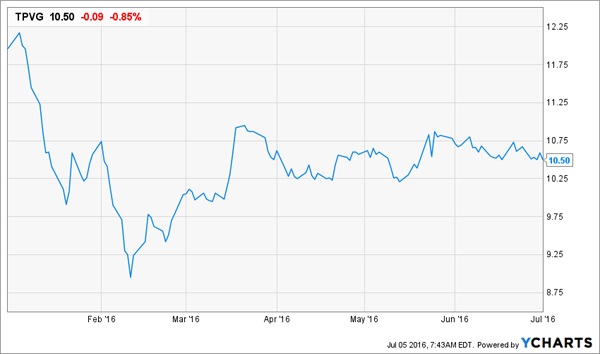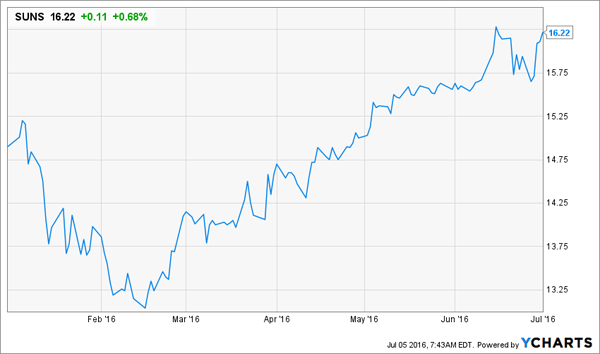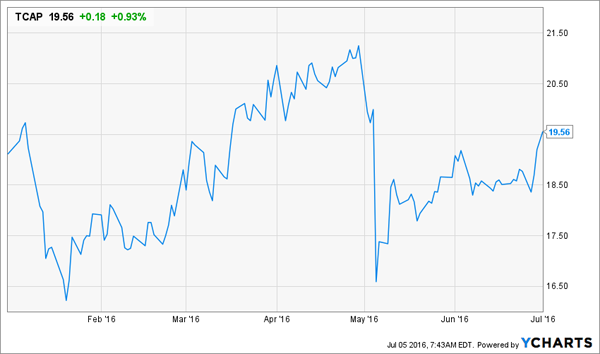Contrary to popular belief, you don’t have to be a multi-millionaire to invest in private equity. In fact, if you have as little as $10 available in a brokerage account, you can do it.
This is especially important nowadays, because the stock market just isn’t cutting it anymore. Let’s face it: 2016 has not been that great for stocks. As we pass the halfway mark for the year, the S&P 500 is up 3%, meaning you’re looking at a 6% gain by the end of the year if the trend continues. For sure, that’s better than Treasuries, but it’s still not that great on a risk-adjusted basis. The risk you are taking in holding stocks is not being properly compensated for by higher returns. The big post-Brexit volatility of 5% losses, not to mention the 10% declines earlier in the year, are proof of this.
If you buy and hold for 20 years, this short-term volatility is no big deal. But if you are a retiree or you need income now, those drawdowns are a serious setback and make receiving your retirement income all but impossible—unless you want to hurt your portfolio at the same time.
Big money managers know this, which is why they are looking at private equity as an alternative to boost overall returns and find an uncorrelated asset class that will not always decline alongside stocks.
You can copy this investing strategy, even if you’re not a multimillionaire. How? By investing in a group of companies that are themselves private equity specialists.
A number of business-development corporations (BDCs) employ the strategy of taking equity in private companies and using that equity to boost the BDC’s overall returns. By law, these BDCs also need to return 90% of their net investment income to investors, so these companies usually pay huge dividends.
Three BDCs in particular are really good at making private equity investments, and have used this strategy to boost their portfolio return for years.
The Tech Strategist

TriplePoint Venture Growth Corp. (TPVG) went public just over two years ago and has been punished harshly by the market just because it happens to be a BDC. That’s unfair; since inception, regular dividends have grown 20% and the stock covers dividends with net investment income (NII) alone, even though its portfolio is not yet fully invested.
TPVG is a savvy tech specialist. Based in Silicon Valley, the company tends to invest in smaller ecommerce and online specialty firms that aren’t big enough to go public but aren’t small enough to disappear. They invest in companies that have a positive cash flow, are profitable, and are seeing strong revenue growth. Buying TPVG is also getting tech exposure.
Oh, and did I mention the stock yields 13.7%? That’s right—a yield that seems impossible for most companies. And for most, it is; but TPVG’s investments yielded 15.7% in the first quarter of 2016, so the fund can easily cover its current yield. How is this possible? Simply put, tech is profitable—if you know how to invest in it. And TPVG does.
The Diversified Specialist

Solar Senior Capital (SUNS) is a BDC that often gets overlooked by investors because it is kind of boring. But boring is good—three quarters in a row of stable net investment income means the company has 100% dividend coverage, which is unsurprising given the company’s investment strategy.
Unlike TPVG, Solar is a P/E investor that focuses on debt, not equity—making it a lower risk BDC than most others. But Solar carries even less risk because of the kind of debt it invests in. A full 100% of Solar Senior’s loans are in, you guessed it, senior debt. These are secured loans with collateral against them, so if the debtor defaults, Solar will still get paid in one form of another.
To make the stock even safer, Solar has a very diversified portfolio. Last quarter the BDC lent to 51 companies in 25 industries, with 2% of its portfolio exposed to one particular company on average. Solar’s biggest industry exposure is to insurance, at 11.4%—followed by professional services (9.6%), financial services (9.5%) and health care services (8.5%). These are relatively safe sectors in today’s market, and Solar has steered clear of energy altogether.
Now for the good part: Solar pays an 8.7% yield at current prices, and it is trading at a 2.8% discount to its net asset value (NAV). Once a great secret thanks to its small market cap, SUNS has received a lot of attention lately, boosting its share price 23% since February. There’s still room to go higher, but that doesn’t matter; that dividend is the real allure of this name.
Old School Middle Market Mavens

Triangle Capital Corporation (TCAP) has stayed true to the idea of the BDC, which was first invented by a 1940 law: invest in important, often unseen, companies that build and improve America’s infrastructure. TCAP’s portfolio is full of companies that sell security systems, automotive components, and even a company that helps brands make perfumes.
These are companies no one has ever heard of, but are essential to the productive American economy, and quietly generate cash flow while the world obsesses over big cap names.
This is why TCAP shareholders are lucky. They can profit off of the dogged endurance of these middle market companies no matter how unsexy they may be. And profits are to be made. Triangle Capital has covered dividends with investment income for over two years, with the important exception of last quarter when a retirement from the board triggered a fee payment that hurt overall net investment income.
That was one reason why TCAP’s dividends were slashed last month, and are now a payout of 9.2% of the company’s current share price. But if we exclude that one-time payment, dividend coverage is 118%, which means a dividend increase is much more likely in the future than a cut.
Diversified Private Holdings and High Income
A portfolio of these three BDCs produces a double-digit average income stream and massive diversification thanks to their investments across industries. With a tech specialist, a diversified business services focused investor, and a traditional industrials focused firm, you are getting exposure to a variety of industries and high income thanks to the stewardship of these firms.
Of course, you can’t throw your money at all of these companies, as the big recent payment to TCAP shows—sometimes fees get in the way of your income. So to avoid too much exposure to one management team, you need to diversify across high income yielding stocks and assets.
This is easy to do, if you know where to look. Hedge fund billionaire Jeffrey Gundlach is fawning over a little-known group of funds paying 7% or more in monthly dividend payments. Of course, there isn’t much time to get in on Gundlach’s strategy. As he recently said, these funds have been trading at a massive discount because investors have lost favor in them—but sentiment will soon swing back. Want to get in before that happens and enjoy the profits Gundlach is looking for? Have a look at Gundlach’s 3 “best plays” today to learn more.
